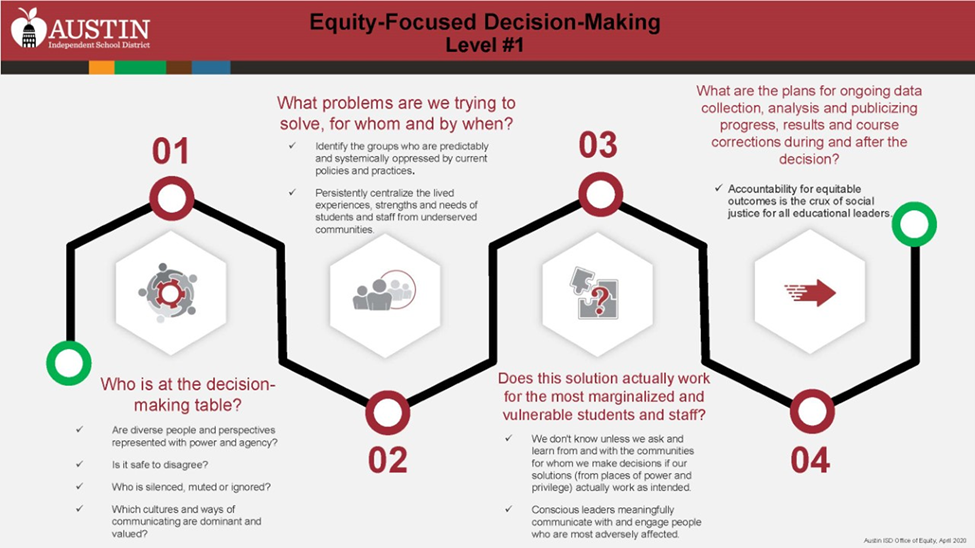Build a Strategic Plan Around Educational Equity
Diversity in schools, organizations, and communities is increasing rapidly. However, blatant inequities throughout society are still hindering students’ success. Students from various backgrounds are affected. Regrettably, schools have not always ensured equitable access to learning and success opportunities. To move forward, we must prioritize equity in education by developing a plan.
Summary
- As communities become more diverse, school leaders must prioritize building a strategic plan that provides equitable access to opportunities for learning and success.
- Equity is not a zero-sum game. When school leaders help the most vulnerable students, everyone else benefits too.
- Considering what it means to be equitable, having conversations about equity is not enough. Education institutions must make equity the foundation of their strategic plan.
Commit to Achieving Equity in Education
In 2019-2020, the Austin Independent School District (AISD) Office of Equity engaged community members to identify how to achieve equity in its education system. As a result, district leaders identified key priorities and integrated them into the district’s five-year strategic plan. Equity was not just a consideration but a foundation of the overall plan, and the district embedded it into almost every strategy it committed to.
Working Towards Equity in Schools
The National Equity Project describes three key priorities to establish more equity in education:
- Ensure equally high outcomes for all participants in our educational system by removing the predictability of success or failure that currently correlates with any social or cultural factor.
- Disrupt inequitable practices, examine biases and create inclusive multicultural school environments for adults and children.
- Discover and cultivate the unique gifts, talents and interests that every human possesses.
To get all leaders on board, AISD relied on research to help leaders understand that equity is not a zero-sum game. When schools help the most vulnerable, everyone benefits. As described in The Curb-Cut Effect, systems designed to benefit marginalized groups often end up benefiting all of society:
There’s an ingrained societal suspicion that intentionally supporting one group hurts another. That equity is a zero-sum game. In fact, when the nation targets support where it is needed most—when we create the circumstances that allow those who have been left behind to participate and contribute fully—everyone wins. The corollary is also true. When we ignore the challenges faced by the most vulnerable among us, those challenges, magnified many times over, become a drag on economic growth, prosperity and national well-being.
– Angela Glover Blackwell
Making Decisions with an Equity Focus
AISD leaders have carefully designed a plan to embed equity in education, including in their own decision-making process. This is an example of one of the tools this team uses for equity policy development and planning:

How to Plan for Equity in Education
In AISD, achieving educational equity means providing each child with what they need to develop their full academic and social potential. As district leaders prepared to develop a new strategic plan, the AISD Equity Office collected data. Using the following nine steps, AISD developed an equity action plan.
- Identify underserved and marginalized groups. Examples include students of color, students with disabilities and students who aren’t native English language speakers.
- Listen to the voice of the adversely affected.
- Conduct root cause analysis with community members.
- Prepare an environmental scan and asset mapping with community members.
- Research promising equity in education practices and industry exemplars.
- Establish the same robust realistic measurable goals over time for all student groups.
- Adapt or develop research-based strategies and tactics with underserved communities to increase equity in education.
- Draft strategic equity in education implementation plan and evaluation.
- Integrate and align appropriate equity tactics into the district strategic plan and action plans.
11 Strategies to Achieve Equity in Education
District leaders in Austin used the above process to devise 11 strategies aligned with the strategic plan for achieving equity in education. Most importantly, the district solicited a tremendous amount of feedback from their community and formed an Equity Advisory Committee to continue pursuing this goal. As a district, leaders hope to use the following 11 strategies to solve these critical problems.
- The system has been failing to meet the social-emotional needs of historically underserved students for decades. This is because of systemic racism and discrimination in funding, hiring, teacher support and development and curricular offerings.
- Discrimination and favoritism in the district have resulted in segregated schools that follow the pattern of city segregation, dispossession and displacement. This stifles the opportunities for students to learn in environments that attract highly qualified and culturally proficient staff.
Culture and Climate
1. Ensure social, emotional, mental, identity and physical safety and wellness are the foundations for learning in our schools.
2. Improve systems for students who receive special education, dyslexia and bilingual services to ensure high expectations and high outcomes for every child.
3. Expand access to enrichment opportunities for students from marginalized communities.
4. Build a culture of respect and inclusion by increasing the diversity of our teaching staff to reflect the racial diversity of the students we serve and fostering growth and well-being for all employees.
Academic Excellence
5. Implement consistent and culturally relevant instruction that is rigorous and rooted in relationships and the community for every child, every day.
6. Serve more young learners from marginalized communities in effective early childhood instruction in AISD.
7. Improve access to quality college and career programs for students from marginalized communities, including connections with higher education institutions and industry partners, and prepare every student with the knowledge and skills to thrive.
8. Prioritize improvement of program opportunities, communication and facility planning for campuses in marginalized communities.
Reflective and Inspirational Leadership
9. Provide teachers and principals with ongoing coaching to foster reflection, analyze disaggregated student data and continuously improve culturally responsive, rigorous and relationship-centered instruction.
10. Engage employees and invite their collaboration to define and deliver “best in class” internal customer service in support of student outcomes.
11. Build trusting relationships with our families and community by engaging with them to listen and improve AISD environments, processes and experiences.
KEY TAKEAWAYS
To harness the desire to improve outcomes for all students into a workable plan that meets the needs of every student, education leaders should:
Think differently.
Although communities have become more diverse, there are still inequities holding students back from success.
Plan differently.
Identify marginalized and underserved groups and develop a plan to adapt research-based strategies and tactics with underserved communities to increase equity in education.
Act differently.
Conversations about equity in education aren’t enough. School leaders must act now to design a more equitable learning environment that supports the needs of all students and offers each the same opportunity for success.



